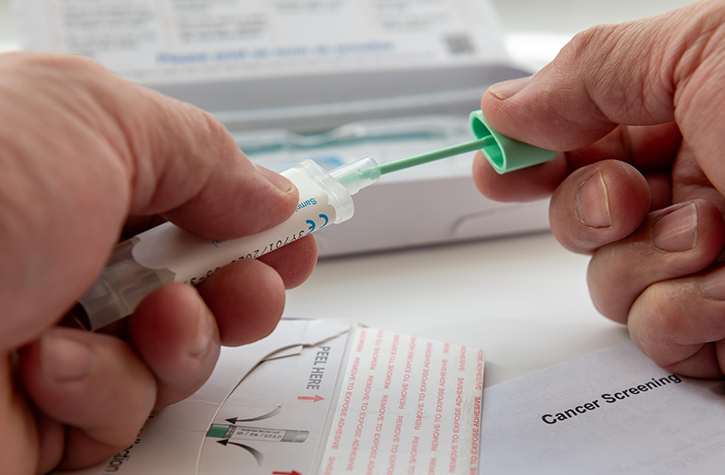May 2, 2024
A new Kaiser Permanente Northern California study found that if an ovarian mass hasn’t grown in 6 weeks, the risk of it being ovarian cancer is less than 1 percent, and if it hasn’t grown in 12 months, the risk of cancer is less than 1 in 1,000.
The researchers say the findings, published in the American Journal of Obstetrics and Gynecology, should be reassuring to both patients and physicians.

Betty Suh-Burgmann, MD
“Many older patients with ovarian cysts or growths but no symptoms or other signs of ovarian cancer often undergo repeat ultrasounds for years out of concern it might be ovarian cancer, even when the cyst is not changing,” said lead author Betty Suh-Burgmann, MD, an adjunct investigator with the Kaiser Permanente Division of Research and a gynecologic oncologist with The Permanente Medical Group (TPMG). “But our study found the risk of cancer for stable masses is very low and continues to decrease over time. This suggests that if a cyst has been stable for at least 12 months, ongoing ultrasound exams may not be necessary.”
The study included 4,750 Kaiser Permanente Northern California patients ages 50 and older who had one or more repeat ultrasounds between 2016 and 2020 for a cyst or growth on an ovary. None had a growth that was 10 centimeters or larger, a genetic mutation that increased their risk for ovarian cancer, or a previous ovarian cancer diagnosis. The 2 most common reasons patients had the initial ultrasound that identified the cyst or growth were pain and abnormal vaginal bleeding.
The research team reviewed patients’ electronic medical records to identify findings on repeat ultrasound examinations 6 weeks to 2 years after the abnormal growth was first detected. They found that in 689 (15%) of the patients, the mass had grown or become more complex by the first repeat exam, while in 4,061 (85%) of the patients, the mass remained stable.
Over the next 3.7 years, a total of 23 women were diagnosed with ovarian cancer. Within the group of 689 patients whose mass had grown by the first repeat exam, 241 had surgery and 12 were diagnosed with cancer. This translates to an ovarian cancer risk of 1.73%.
Among the 4,061 women whose ovarian mass had not changed, 491 had surgery and 11 were diagnosed with ovarian cancer. This translates to an ovarian cancer risk of 0.27% — 6 times lower than that of the patients whose mass had grown by the first follow-up exam. The research team then looked more closely at the 1,142 patients within this group whose exams showed no growth for at least 12 months. None of these women had an ovarian cancer diagnosis.
Providing answers
The American College of Obstetrics and Gynecology guidelines currently recommend repeat ultrasound imaging for patients with ovarian masses but no symptoms of ovarian cancer. They have been unable to recommend how often, or for how long, repeat imaging is necessary because few studies had evaluated this question.
“I wanted to do this study because this is something I commonly see in my own practice,” said Dr. Suh-Burgmann. “Repeat imaging is time-consuming, often is costly to patients, and it can cause patients a lot of anxiety. Also, each time we do an imaging exam, we may find something extra, unrelated to the reason for the test — what we call an incidental finding — that can increase the likelihood of having an unnecessary surgery for something that is not cancer and didn’t really need to be removed.”
In 2016, Kaiser Permanente Northern California implemented a standardized reporting system that provides a consistent means of assessing ovarian mass growth. The system, which Dr. Suh-Burgmann helped to develop, made this study possible.
“There are many different words radiologists might use to describe an ovarian mass, and without our standardized reporting it would be difficult to determine if a mass being described was stable over time,” said Dr. Suh-Burgmann. “Because we had implemented this system, we were uniquely positioned to do this study.”

Kari Carlson, MD
The American Cancer Society estimates that about 19,680 women will be diagnosed with ovarian cancer in 2024. There is no screening test for ovarian cancer, and it is typically diagnosed in older women. Ovarian cysts or small masses are common but can raise concern for ovarian cancer.
“For women to know that the risk of cancer is very low to zero will help alleviate anxiety or concern,” said Kari Carlson, MD, an obstetrician/gynecologist and associate executive director for TPMG. “From a health care delivery perspective, these findings will help guide follow-up recommendations that save these patients time as well as free up appointments for others.”
Dr. Suh-Burgmann said future research is necessary to determine the optimal follow-up schedule during the first year after a mass is found and to better determine which types of changes seen on an ultrasound should lead to a recommendation for surgery.
But for now, she said, “I think our patients and physicians should feel reassured by our finding that the risk of ovarian cancer among older patients with a stable mass is extremely low. Given this, the likelihood of benefit to ongoing ultrasound monitoring, particularly beyond 12 months, is low and may be outweighed by the potential risks of repeated imaging.”
Co-authors include Yun-Yi Hung, PhD, and Julie Schmittdiel, PhD, of the Division of Research.
The study was funded by The Permanente Medical Group Physician Researcher Program.
This article originally appeared on Division of Research Spotlight.






